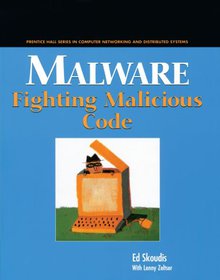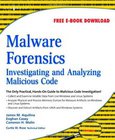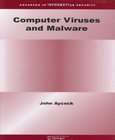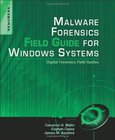Malware
Fighting Malicious Code

Book Details:
| Publisher: | Prentice Hall |
| Series: | Prentice Hall |
| Author: | Ed Skoudis |
| Edition: | 1 |
| ISBN-10: | 0131014056 |
| ISBN-13: | 9780131014053 |
| Pages: | 672 |
| Published: | Nov 17 2003 |
| Posted: | Nov 19 2014 |
| Language: | English |
| Book format: | CHM |
| Book size: | 6.34 MB |
Book Description:
Malicious code is a set of instructions that runs on your computer and makes your system do something that you do not want it to do. For example, it can delete sensitive configuration files from your hard drive, rendering your computer completely inoperable; infect your computer and use it as a jumpingoff point to spread to all of your buddies' computers; and steal files from your machine. Malicious code in the hands of a crafty attacker is indeed powerful. It's becoming even more of a problem because many of the very same factors fueling the evolution of the computer industry are making our systems even more vulnerable to malicious code. Specifically, malicious code writers benefit from the trends toward mixing static data and executable instructions, increasingly homogenous computing environments, unprecedented connectivity, an ever-larger clueless user base, and an unfriendly world. Skoudis addressed malicious code in just one chapter of his previous book. Here, a dozen chapters focus on one of the most interesting and rapidly developing areas of computer attacks. *Chapter 11, "Defender's Toolbox," rolls together the defensive strategies described in the book. As a bonus, Skoudis gives recipes for creating your own malicious code analysis laboratory using cheap hardware and software. *Foreword by Gene Schultz, security inspector for Global Integrity.
Download Link:
Related Books:
Malware Forensics
Investigating and Analyzing Malicious Code
Malware Forensics: Investigating and Analyzing Malicious Code covers the emerging and evolving field of "live forensics," where investigators examine a computer system to collect and preserve critical live data that may be lost if the system is shut down. Unlike other forensic texts that discuss "live forensics" on a particular operating system, or in a generic context, this book emphasizes a live forensics and evidence collection methodology on both Windows and Linux operating systems in the context of identifying and capturing malicious code and evidence of its effect on the compromised system. Malware Forensics: Investigating and Analyzing Malicious Code also devotes extensive coverage of the burgeoning forensic field of physic...
Computer Viruses and Malware
Our Internet-connected society increasingly relies on computers. As a result, attacks on computers from malicious software have never been a bigger concern. Computer Viruses and Malware draws together hundreds of sources to provide an unprecedented view of malicious software and its countermeasures. This book discusses both the technical and human factors involved in computer viruses, worms, and anti-virus software. It also looks at the application of malicious software to computer crime and information warfare. Computer Viruses and Malware is designed for a professional audience composed of researchers and practitioners in industry. This book is also suitable as a secondary text for advanced-level students in computer science....
Malware Forensics Field Guide for Windows Systems
Digital Forensics Field Guides
Dissecting the dark side of the Internet with its infectious worms, botnets, rootkits, and Trojan horse programs (known as malware) is a treaterous condition for any forensic investigator or analyst. Written by information security experts with real-world investigative experience, Malware Forensics Field Guide for Windows Systems is a"tool" with checklists for specific tasks, case studies of difficult situations, and expert analyst tips.*A condensed hand-held guide complete with on-the-job tasks and checklists *Specific for Windows-based systems, the largest running OS in the world *Authors are world-renowned leaders in investigating and analyzing malicious code...
2007 - 2021 © eBooks-IT.org



